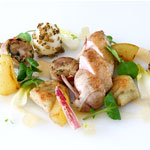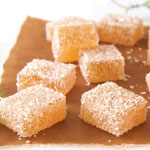Peared up
The pear is one of the most versatile additions to a recipe as it mixes well with a wide variety of ingredients. Madalene Bonvini-Hamel, founder of The British Larder, reports
One of the best autumn treats is the humble pear. There is a vast number of varieties on the market, but most have been imported; somehow we seem to have forgotten our own fruits.
For example, some might argue that the British Conference pear is not the prettiest or most valued fruit. However, it makes a fantastic and interesting cooking ingredient.
I had an enormous amount of fun preparing these spectacular pear recipes. Some are old friends that I have dusted off; others have been adapted to make use of the fruit.
The pear mixes well with a wide variety of ingredients and as the flavours mingle, the character changes. This makes the pear even more valuable to me as a chef, as the possibilities are endless.
The thing I like most about the pear is that it does not matter at which stage of ripeness it is eaten. Furthermore, it can be used as a cooking ingredient while hard or soft.
I find the Conference pear, with its russet skin and elongated shape, very attractive. It is an early variety, and the flesh is hard and perfect for cooking. I like to grate a Conference pear, skin and flesh, into muffin batter as it provides both fibre and moisture.
Later in the season, a more fragrant pear is available, when Williams and Comice varieties ripen. I love the texture and graininess of the flesh, together with their aromatic scent.
The Williams pear, with its golden yellow tinge, is juicy and sweet with firm flesh. It is perfect for cooking but once ripe it makes a pleasant eating pear. The Comice, a French variety, is classed by many as the superior eating pear, with its tender, aromatic, rich buttery flavour and texture. I find it perfect for making sorbets and parfaits with attitude.
A RICH HERITAGE
The pear has been cultivated for 4,000 years. It used to be considered superior to the apple and outnumbered it in terms of the varieties grown.
The Domesday Book contains references to the cultivation of pears as boundary markers, and Shakespeare mentioned the first important English pear, the Wardon (a cooking variety), in his work. The number of varieties grown in Britain by the late 19th century peaked at over 700. Today, however, the Conference pear accounts for the vast majority of commercially grown pears in Britain.
At Brogdale Farm in Kent, home of the National Fruit Collection, they are working to protect old varieties of fruit and prevent them from dying out. The site includes more than 3,500 named pear, apple, plum, cherry, bush fruit, vine and cobnut cultivars, and to visit it is a humbling experience. The work they do is incredibly important to Britain and should protect the heritage and future of the pear.
PEAR, QUAIL, WALNUT AND BLUE CHEESE SALAD
(Serves four)
BLUE CHEESE GNOCCHI
Ingredients
- 250g Desiree potatoes
- 50g strong flour
- 30g semolina, plus extra for dusting
- 75g crumbed mature Stilton cheese
- 1 small free-range egg
- Salt and freshly cracked black pepper
Method
Preheat the oven to 100°C. Peel and roughly dice the potatoes, then boil them in salted water until soft. Drain the potatoes, lay them on a baking tray and place in the oven for 10-20 minutes to remove any excess water. Place the flour and semolina in a Thermomix and blend for 30 seconds on speed 10. While the potatoes are still warm, pass them through a food mill with the crumbed Stilton, milled flour and seasoning. Mix in the egg and rest the gnocchi mixture in the fridge for one hour.
Next, bring a large saucepan of salted water to the boil. Lightly dust a clean work surface with semolina, divide the gnocchi mixture into six even-sized balls, then roll each ball into a thin, long sausage with the diameter of a 20p piece. Cut each piece into 1.5cm long pillows, using a fork to mark one side of the gnocchi. Blanch the gnocchi in rapidly boiling salted water for two minutes, or until they float, then transfer them with a slotted spoon to an iced water bath to cool them rapidly. Drain the gnocchi and toss with olive oil. Keep them refrigerated until needed.
QUAIL AND PANCETTA SAUSAGE
Ingredients
- 4 quails' legs
- 2 slices of lemon
- 1 sprig of thyme
- 60g chicken breast meat
- 70ml double cream
- Salt and freshly cracked black pepper
- 1tbs chopped watercress
- 50g morel mushrooms
- 1tsp unsalted butter
- 6 slices of pancetta
- Few drops of fresh lemon juice
Method
Preheat the water bath to 68˚C. Season the quails' legs with the salt and pepper, then place them in a vacuum bag with the lemon slices and the thyme. Seal on hard vacuum. Cook for 50 minutes in the water bath. Once cooked, cool in iced water. Flake the quails' leg meat from the bones and remove the skin. Sauté the morel mushrooms in the butter until golden, then drain them on kitchen paper and roughly chop.
Place the chicken breast meat in the Thermomix bowl, blend for 30 seconds on speed 10, scrape the sides down and repeat the process until the meat is smooth. Pass the chicken purée through a fine sieve to remove the connective tissue. Transfer to a small bowl, add seasoning and then whip in the cream bit by bit. Do not overwork the mousse.
Fold the flaked quail meat, chopped watercress and chopped sautéd morel mushrooms into the chicken mousse and season to taste. Transfer the mixture to a disposable piping bag.
Lay a double layer of clingfilm on the work surface. Cut the pancetta slices in half and lay them on the clingfilm to form a long rectangle.
Cut an opening in the piping bag about the size of a 20p piece, and pipe the mixture onto the pancetta slices. Roll the pancetta up to form a sausage with the help of the clingfilm. Secure the openings of the clingfilm. Poach the sausage in the preheated water bath at 68˚C for 20 minutes, then cool it over ice. Reshape and roll the sausage up in clean clingfilm once chilled to secure the round shape. Set in the fridge.
QUAIL BREAST
Ingredients
- 2 small quails' crowns
- 25g unsalted butter
- 2 slices of lemon
- 2 sprigs of thyme
Method
Preheat the water bath to 68˚C. Clean the quails' crowns and pat them dry with kitchen paper. Heat a non-stick frying pan, then season the crowns and sauté with the butter until golden brown all over. Place the crowns in two separate small vacuum bags with one slice of lemon and one sprig of thyme per bag. Seal on hard vacuum and cook for 20 minutes in the water bath.
Chill the crowns in iced water until completely cold. Next, remove the crowns from the bags, remove the breast from the carcass, drain on kitchen paper, and set aside until ready to serve.
PICKLED WALNUT SALT ENCRUSTED QUAIL'S EGGS
Ingredients
- 4 quails' eggs
- 1 pickled walnut, drained
- 1tbs Maldon Sea salt
Method
Bring a small saucepan with water to the boil, add the quails' eggs and soft boil for two minutes and 30 seconds. Then, cool and peel the eggs, finely chop the pickled walnut, lay it on a tray and let it dry out. Add the salt and then return the dried chopped walnut and salt to the chopping board and chop until very fine. Roll each quails' egg in the pickled walnut salt, set aside.
PEAR JELLY
Ingredients
- 1 ripe Conference pear
- 200ml water
- 1.4g agar
Method
Peel, core and slice the pear, then place it with the water in a small saucepan, bring to the boil and simmer for six minutes. Purée the boiled pear, including the water.
Set a square flat container in position, not to be moved once the hot jelly is poured into the container. Return the pear purée to the heat, whisk in the agar and bring the purée to the boil for one minute. Pour the hot pear jelly into the container, leave to set at room temperature, and do not move the container before the jelly is set, as any agitation will prevent it from setting.
SAUTED HONEY PEARS
Ingredients
- 1 firm Conference pear
- 1tsp Rowse Scottish heather honey
- 1tsp unsalted butter
Method
Peel, core and quarter the pear. Cut each quarter into five pieces and place in a vacuum bag. Add the honey and seal on hard vacuum; let the pears macerate overnight.
Open the pouch and drain the pears. Heat a small non-stick frying pan with the butter, and once the butter starts to foam, add the pears and sauté until golden brown. Drain on kitchen paper.
ASSEMBLY OF THE DISH
Ingredients
- 4 prepared quails' breasts
- 1tbs unsalted butter
- 12 slices of quail and pancetta sausage
- 20 pieces of honey pears
- 4 pickled walnut and salt encrusted quails' eggs
- Mixture of red and white chicory and watercress salad
- 20 Stilton gnocchi pillows
- 32 pieces of pear jelly cut in 5mm x 5mm dice
Method
Heat a non-stick frying pan, sauté the gnocchi until golden in a bit of the butter and drain on kitchen paper. Sauté the sausage slices until golden on both sides and drain on kitchen paper. Sauté the quail breast for two minutes on the skin side. Arrange the quail sausage slices, sautéd honey pears, gnocchi, jelly, quail's eggs and salad leaves. Slice the quail's breast in three and place in position on the plate.
CAMOMILE-SMOKED PEAR PASTILLES
INGREDIENTS (Makes 24 pastilles)
- 10g fresh camomile
- 330g caster sugar
- 50ml water
- 500g Conference pears
- 50g loose camomile tea
- Juice from one lemon
- 180g glucose
- 20g pectin
- Golden caster sugar for garnish
METHOD
Place the fresh camomile, 30g of caster sugar and water into a small saucepan over a low heat. Dissolve the sugar and bring the syrup to the boil. Cook for two minutes.
Peel, core and cut the pears into quarters, then place in a vacuum bag with the camomile syrup and seal on hard vacuum. Let the pears infuse overnight.
Drain the pears and keep the syrup. Place the pears on a cooling rack. Mix half of the camomile tea with 30ml of cold water, and leave to soak for 30 minutes. Spread the soaked tea over a roasting tray and mix the rest of the dry tea in with the wet tea. Place the cooling rack over the tea.
Cover the tray with foil and place the tray over a naked flame. The tea will start to smoke, and once you have a sufficient amount of smoke remove the tray from the naked flame, and set aside for 30 minutes so the pears take on the flavour of the smoke.
Line a 14cm x 21cm x 1.5cm tray with a double layer of clingfilm.
Place the pears and the retained liquid into the bowl of the Thermomix and blend for five minutes on speed 10.
Place 500g of the pear purée and glucose in a medium-sized saucepan, bring to the boil, reduce the heat to a gentle simmer and cook until the purée reaches 107°C.
Mix 300g of caster sugar with the pectin and add to the boiling pear mixture. Melt the sugar, bring the mixture back to the boil and cook until it reaches 107°C for the second time. Immediately pour the boiling hot mixture into the lined tray and leave to set completely at room temperature.
Cut the pear pastilles into squares and roll each square in golden caster sugar.













